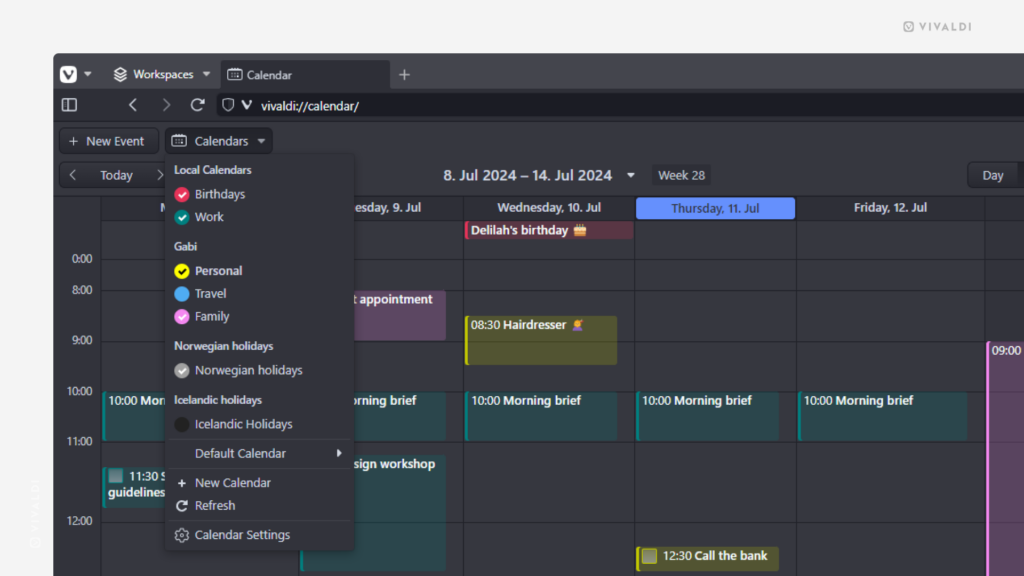Desktop Tips
Tip #547
August 22, 2024
Choose which websites can see your exact location.
Geolocation can be a convenient feature, but not every service provider needs to know where in the world you are. That’s why, in Vivaldi, you control which websites can access your location.
By default, every new website that wants to access your location will ask for your permission and you can either allow or block access. You can update the default setting and review which sites have requested permission in Settings > Privacy and Security > Website Permissions.
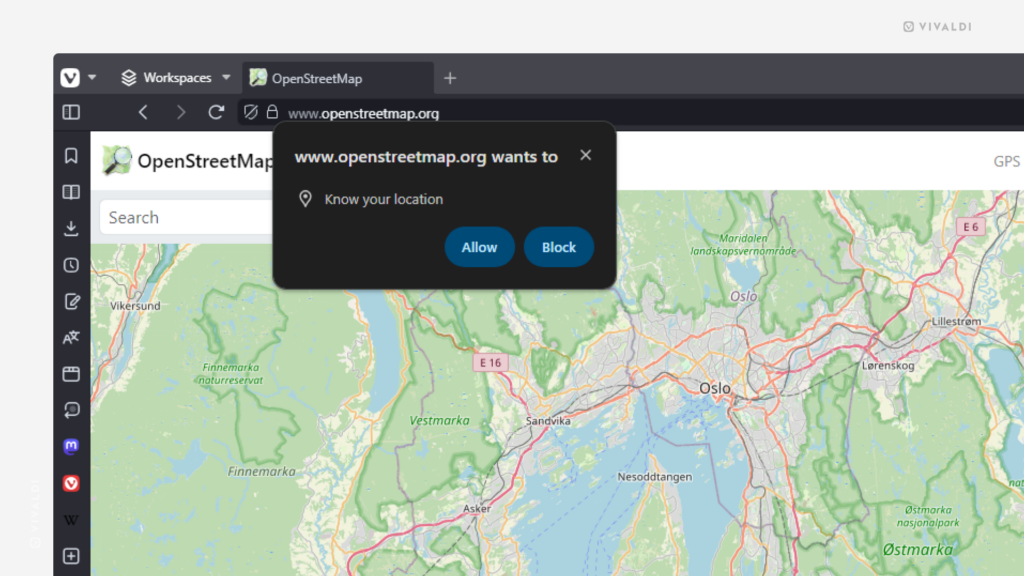
Tip #546
August 21, 2024
Watch our new video series “Vivaldi 101” and learn more about the possibilities of your favorite browser, Vivaldi!
Do you like to learn about Vivaldi by watching videos? You’re in luck because we have a new video series introducing you to the browser’s features and showing you how to customize the browser according to your preferences.
To be notified about new videos in the series, add our YouTube channel to Vivaldi Feeds following the instructions in Tip #40, or subscribe to the Vivaldi channel directly on YouTube.
Tip #543
August 12, 2024
Get a sneak peek of the emails from previews in the Message List.
When dealing with a lot of mail, seeing the first few lines of the message can help to gauge the importance of the email – whether to open it immediately or leave it for later.
To adjust your preview settings:
- Go to Settings > Mail > Mail Settings > Message List Preview.
- Choose how many lines of text you want to see (0-3).
Also, make sure that “Download Messages to Generate Previews on Demand” is enabled and if you’re using a horizontal layout in Vivaldi Mail, disable “Only Show Message Preview in Vertical View”.
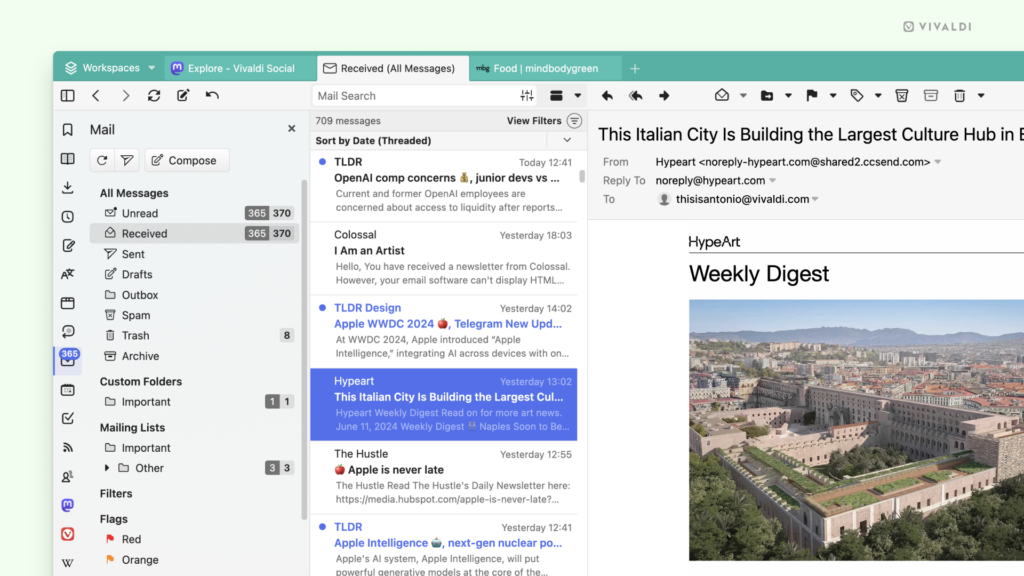
Tip #541
August 8, 2024
Skip to the right section in Quick Commands with Keyboard Shortcuts.
In Quick Commands you’ll find your open and recently closed Tabs, Bookmarks, History, Page Actions, a list of available commands in Vivaldi, Command Chains, and more. You can scroll with your mouse or use the arrow keys on your keyboard to navigate the available options and search results. Depending on what you’re looking for that can take time, so it’s best to just skip to the right section.
To move between sections in Quick Commands, hold down the Alt key while using the ↓ down and ↑ up arrow keys.
Tip #539
August 6, 2024
Keep your Saved Sessions relevant with quick edits in the Sessions Panel.
Saving your open tabs as sessions allows you to access them all with just a few clicks at any point. To make your sessions even more useful, manage the tabs within the session to keep them neat and organized.
To edit Saved Sessions:
- Open the Sessions Panel.
- Right-click on the session you want to update and select “Edit / View Contents”.
- Make the changes. For example, pin or move tabs, (un)stack them, rename, etc.

Tip #538
August 5, 2024
See what’s planned for the day by enabling the day view sidebar in Vivaldi Calendar.
To get a general overview of your calendar at the same time as focusing in on a specific day, make use of Vivaldi Calendar‘s sidebar which displays the selected day’s events and tasks next to your current calendar view.
To toggle the sidebar in the Calendar on and off:
- Open the Calendar in the main tab view.
- Near the top right corner, below search and next to trashed events, click on the “Show Sidebar” button.
The day view sidebar is available in week, multiweek, month, and year views. In the agenda view, the sidebar will display your tasks.
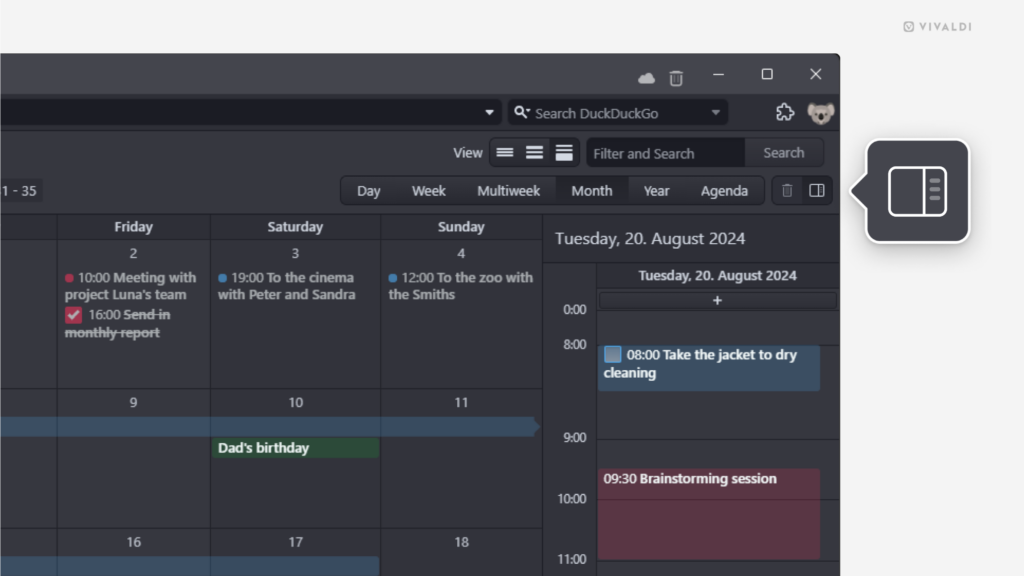
Tip #535
July 30, 2024
Pick a default sender email address for Vivaldi Mail.
If you tend to send more emails from one account than others, consider making it the default sender in Vivaldi Mail. That way, you don’t need to double-check with each new email you’re writing, from which address it’ll be sent.
To set a default sender in Vivaldi Mail:
- Go to Settings > Mail > Mail Settings > Default Sender in New Messages.
- Select your preferred email address.
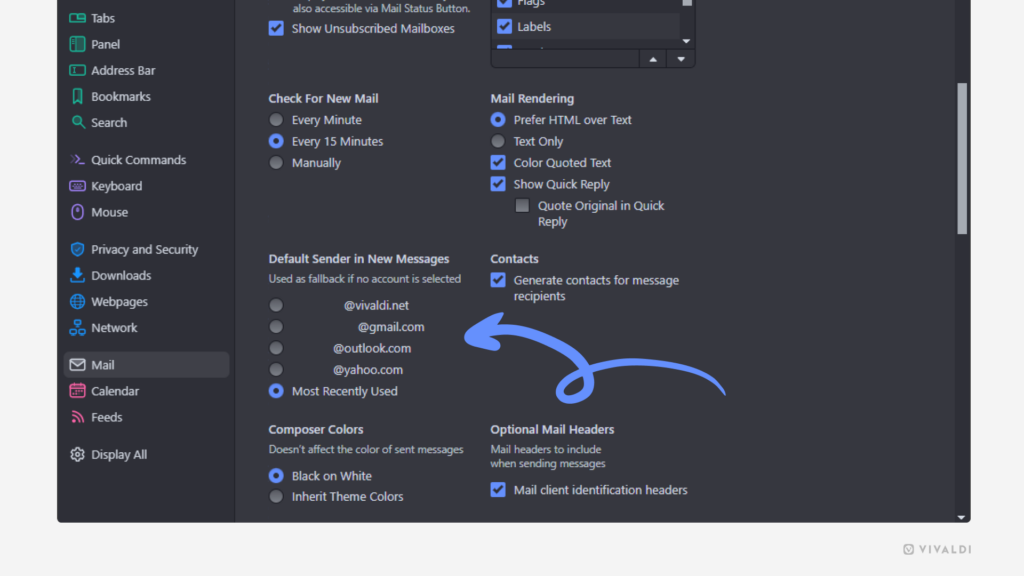
Tip #534
July 29, 2024
Keep your browsing private and clean by turning off Typed History.
Suppose you want to hide your recent searches and typed web addresses from view, for example, because you often have people peaking at your screen or you like to keep the information in the drop-down menus to the minimum. In that case, you can disable Typed History from showing up.
To hide typed history from the Address Field and Search drop-down menus:
- Go to Settings > Privacy and Security > Privacy > Show Typed History.
- Untick the “In Address Field” and/or “In Search Field” boxes.
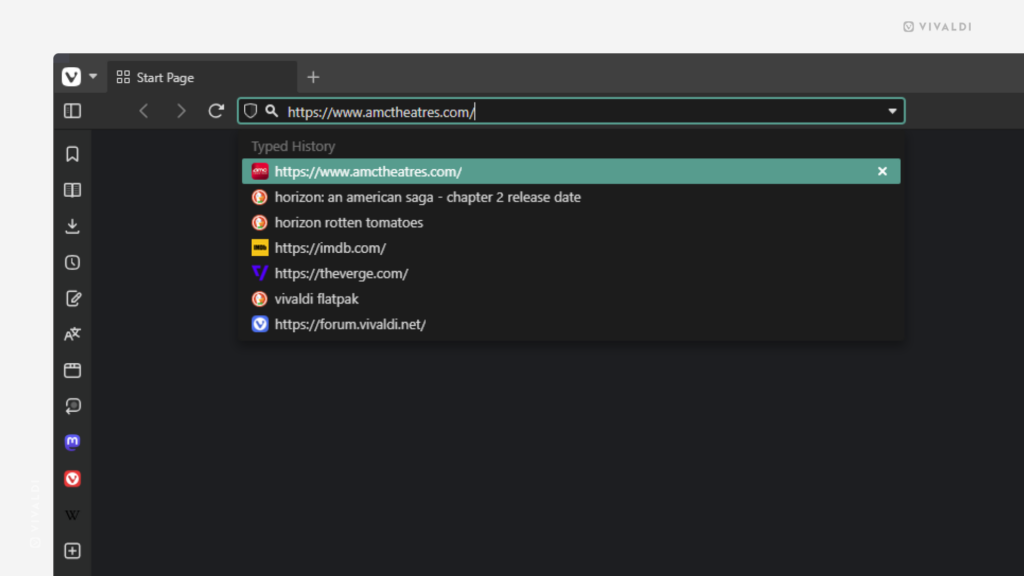
Tip #531
July 24, 2024
Go for a minimalistic and cleaner look with transparent background tabs.
Some of the adjustments you can make to your Vivaldi Theme are more subtle than others. One such customization option is removing the faint background from the tabs you have open in the background.
To make background tabs transparent:
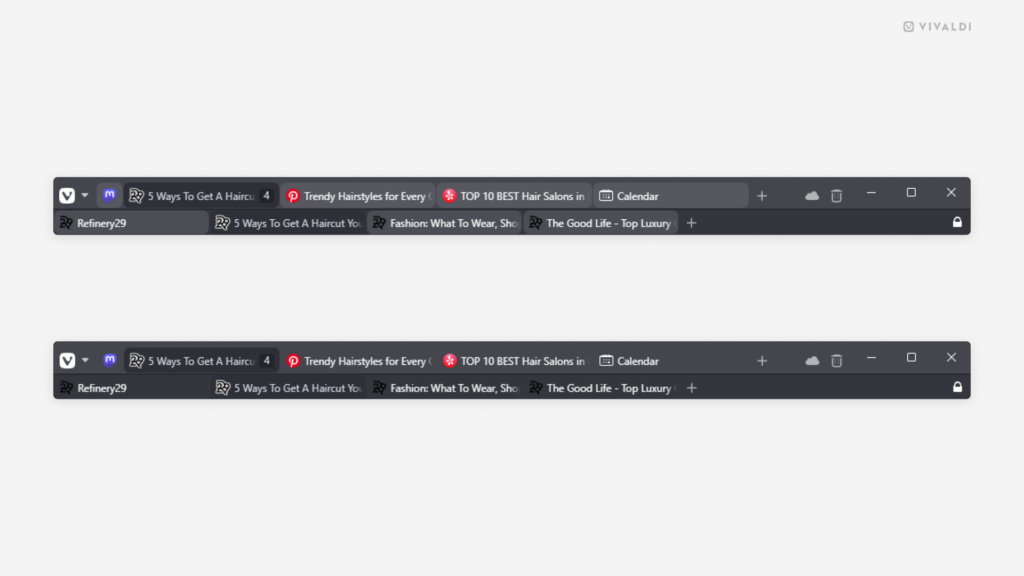
Tip #530
July 23, 2024
Play around with different layouts for creative ways to arrange your Speed Dials.
When you have a lot of Speed Dials on your Vivaldi browser’s Start Page, you’ll benefit from spreading them out into more columns, so they’ll all fit on the screen. But if you only have a few favorites, you can get more creative with the layout.
To change the number of columns:
- Go to Settings > Start Page > Speed Dial or open Quick Settings > Speed Dial Appearance on the Start Page.
- From the Maximum Columns drop-down menu, select how many columns of Speed Dials you want. You can have a single column or go in the opposite direction and remove the upper limit altogether.
Theme by abeegeorgina.
Tip #529
July 22, 2024
Pick the appropriate default search scope in Vivaldi Mail.
Do you prefer to start searching by casting a wide net and hoping the best result shows up that way or do you like to start small and expand if nothing good comes up? By changing the default search folder (All messages vs Current Folder) in Vivaldi Mail, you can tailor the mail client to match your style. If the default isn’t a good match for a particular search you can always adjust the scope in search filters.
To change the default search folder.
- Go to Settings > Mail > Mail Settings > Default Search Folder.
- Select whether to always search through all messages or only in the folder you currently have open.
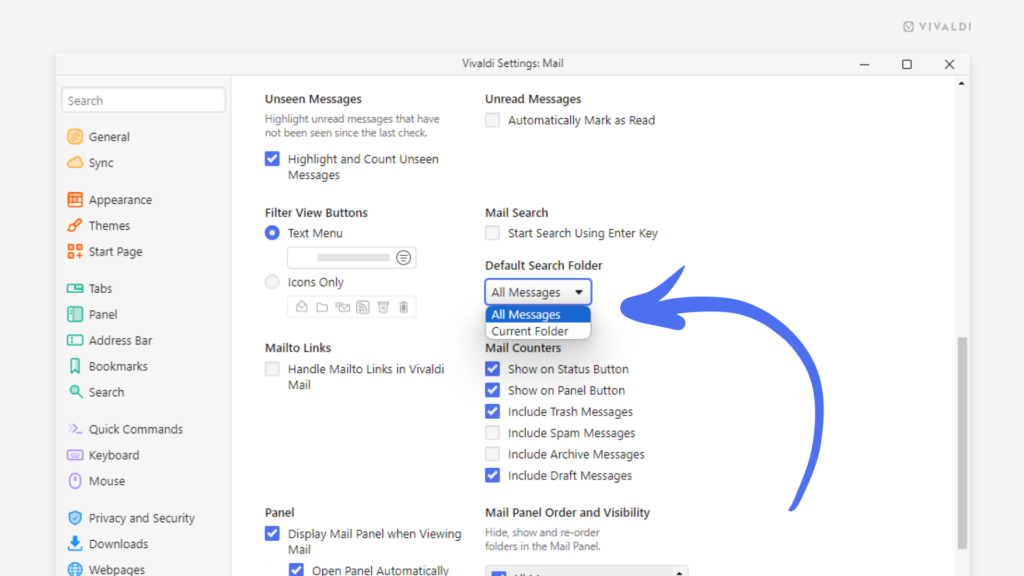
Tip #525
July 11, 2024
Hide unneeded calendars in Vivaldi Calendar temporarily from view.
When you’re trying to get an overview of what’s planned in a certain aspect of your life, hiding irrelevant events and tasks from view in the Vivaldi Calendar helps to focus on what’s important at the moment.
To toggle the visibility of calendars in the main calendar view:
- Click on “Calendars” in the top left corner of the page.
- Click on the calendar’s name to hide/show its events.
To toggle the visibility of calendars in Calendar settings:
- Go to Settings > Calendar > Calendars.
- Select a calendar.
- (Un)tick the box for “Hide from Calendar View”
- Click “Save”.
